Redis integer set cannot be downgraded? Why?
I believe some students have never heard of integer collection, because redis only provides five encapsulated objects to the outside world! Previously, we analyzed the three data structures of redis: List, Hash, and Zset from the internal structure of redis. Today we will analyze how the set data structure is stored internally.
Basic structure
In src/t_set.c we found such a piece of code
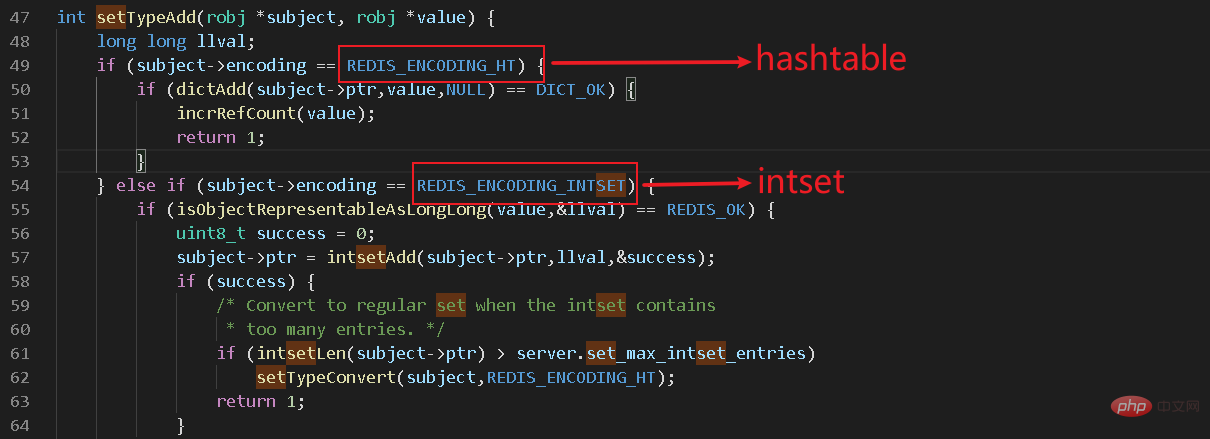
From this we can know that in set it is composed of Composed of two data structures: hashtable intset. Regarding other internal structures of redis, I specifically introduce them in [redis column]. Hashtable is not our protagonist today. Today we first analyze intset, commonly known as integer set.

As we can see from the above picture, I constructed two set collections, namely [commonset] and [cs]. The former stores strings and the latter stores numbers.
We looked at the underlying data structures of the next two collections through the object encoding key and found that one is a hashtable and the other is an intset. This also verifies our description of the basic structure of set above.
The five major types provided externally in redis are actually an abstract object of redis called redisobject. The internal data structure of our redis is mapped internally

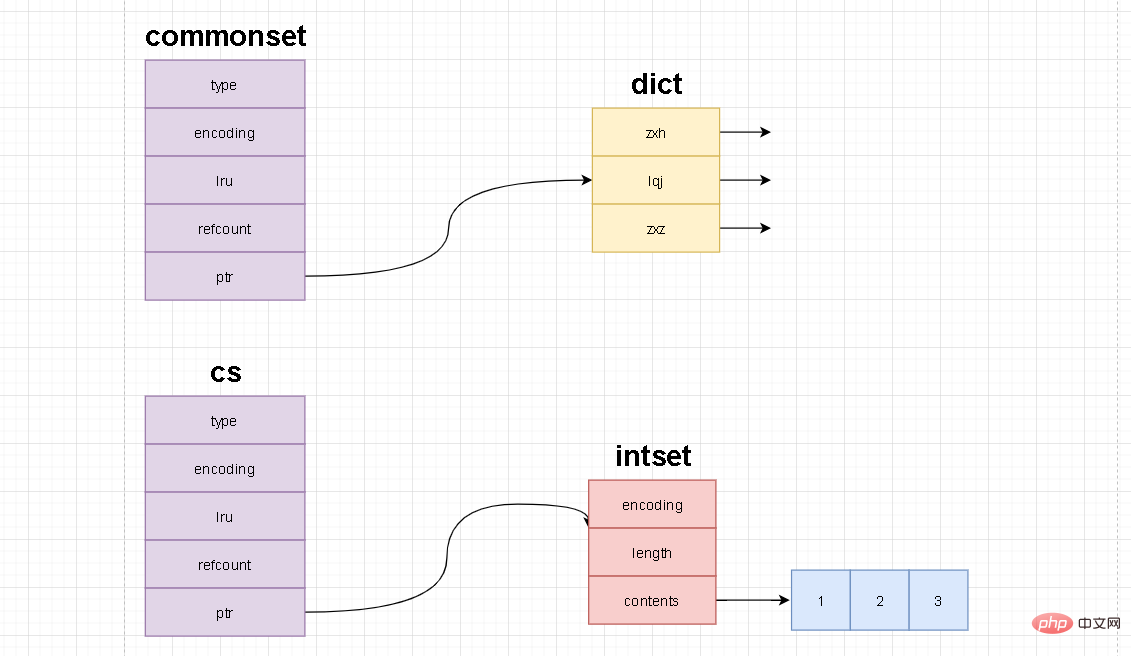


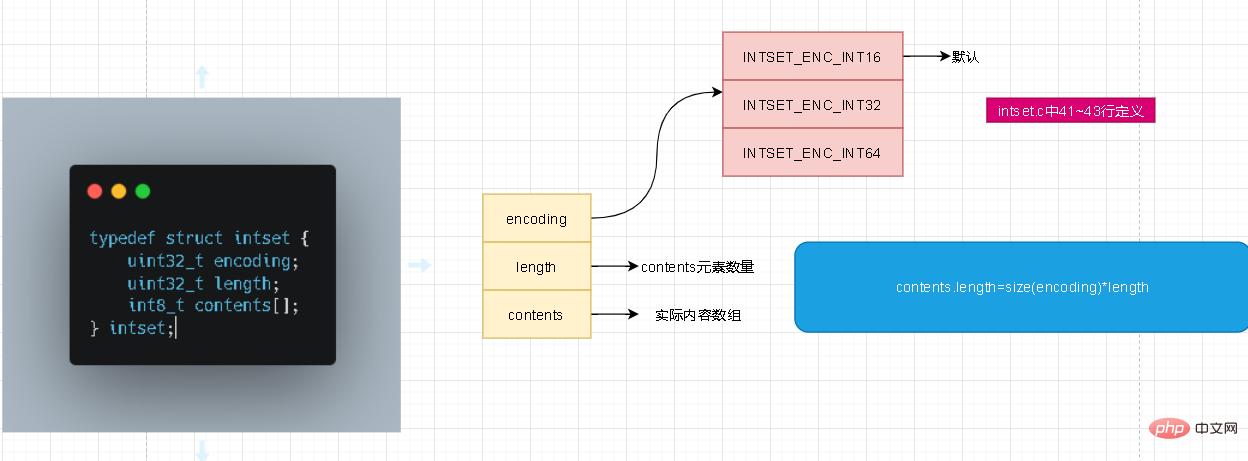
\[-2^{7} \sim 2^{7}-1 \\that is \\
-128 \sim 127
\]

sadd juejin -123
sadd juejin -6
sadd juejin 12
sadd juejin 56
sadd juejin 321
Copy after login
juejin The key inside is intset.
sadd juejin -123 sadd juejin -6 sadd juejin 12 sadd juejin 56 sadd juejin 321
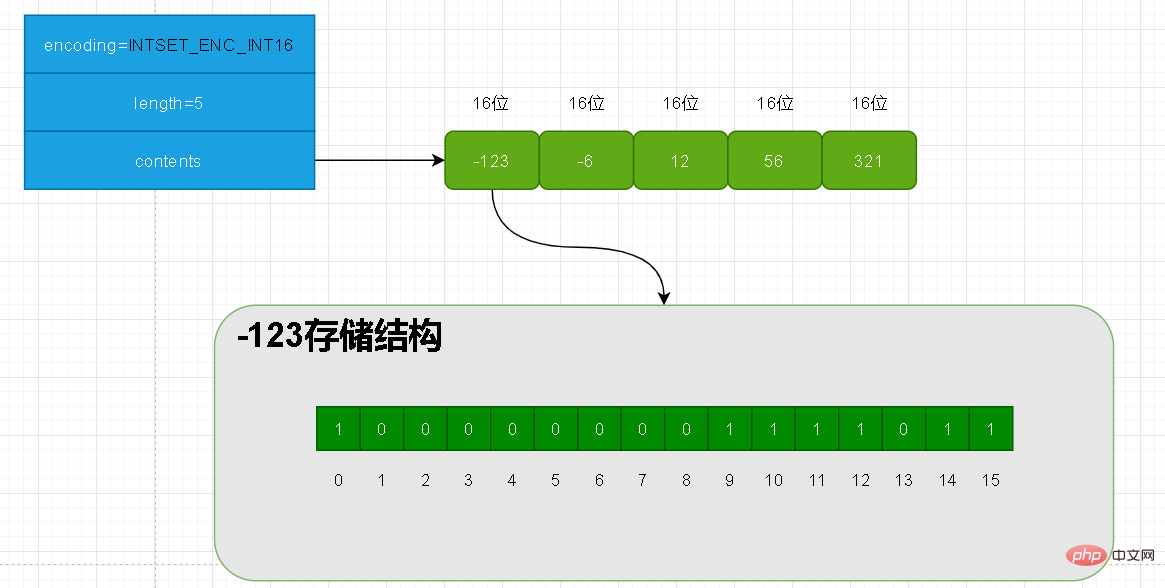
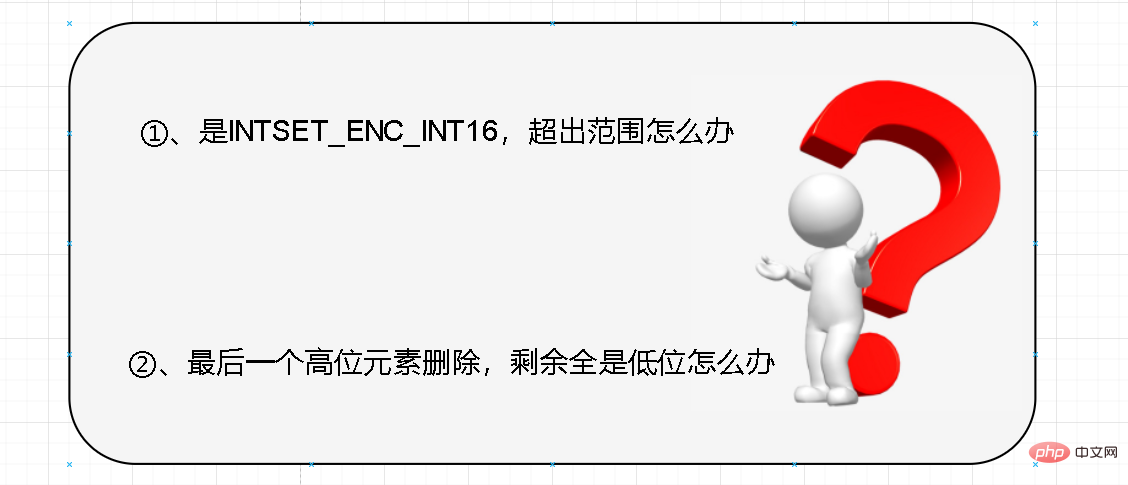
The answer is definitely not possible. First of all, direct appending cannot guarantee the order of the array elements! Secondly, if the first five are 16 bits each and the sixth one is 32 bits, then there are no extra fields in the intset structure to mark. In other words, it is impossible to judge whether 16-bit or 32-bit should be parsed during parsing.
In order to facilitate parsing, redis will upgrade the entire contents when high length is added. It means to expand the entire contents first, and then refill the data

and add 65535
. First, the expansion can be determined based on the length. The number of elements is 6, and each occupancy is 32, so the contents length is 32*6=192. At this time, the first 80 bits of content remain unchanged
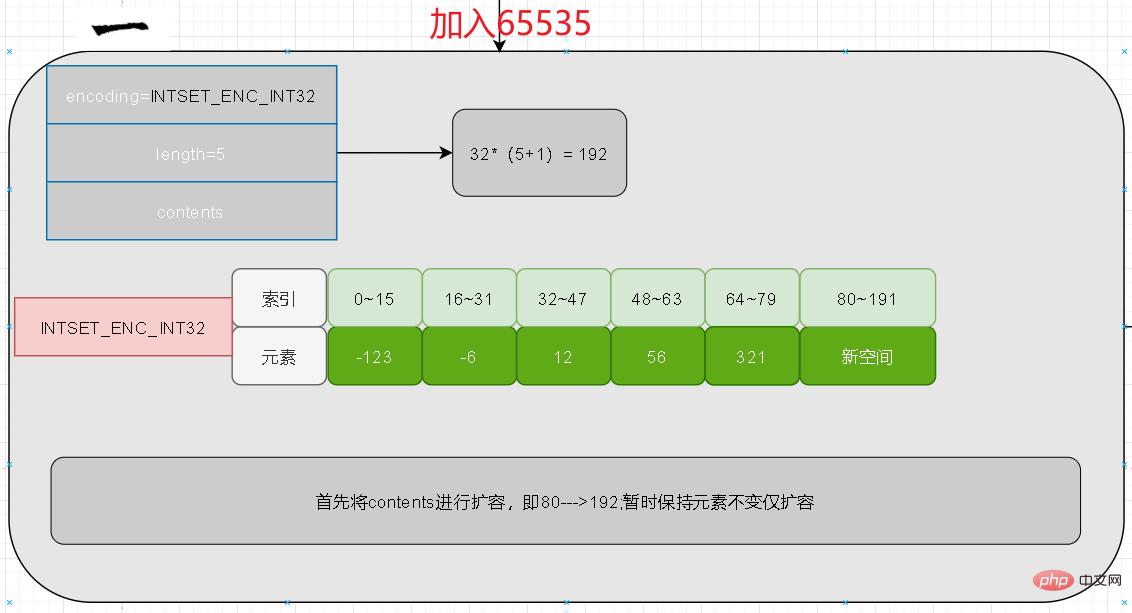
Old data shift
After enough space has been opened up, we can The old data is shifted. Here we start moving from the end of the original array. Before moving, we need to clarify the sorting position in the new array.
At this time, we first compare 321 to determine that his ranking is fifth in the new array, then he will occupy the range 128~159 in the new contents.
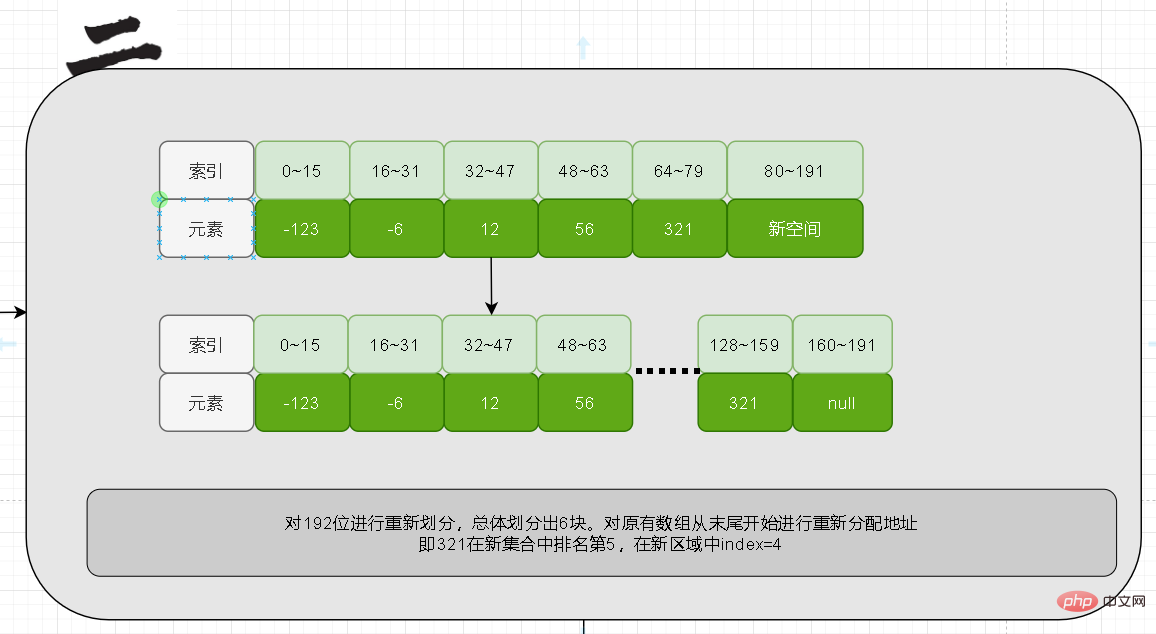
Finally the first 5 elements will be moved.
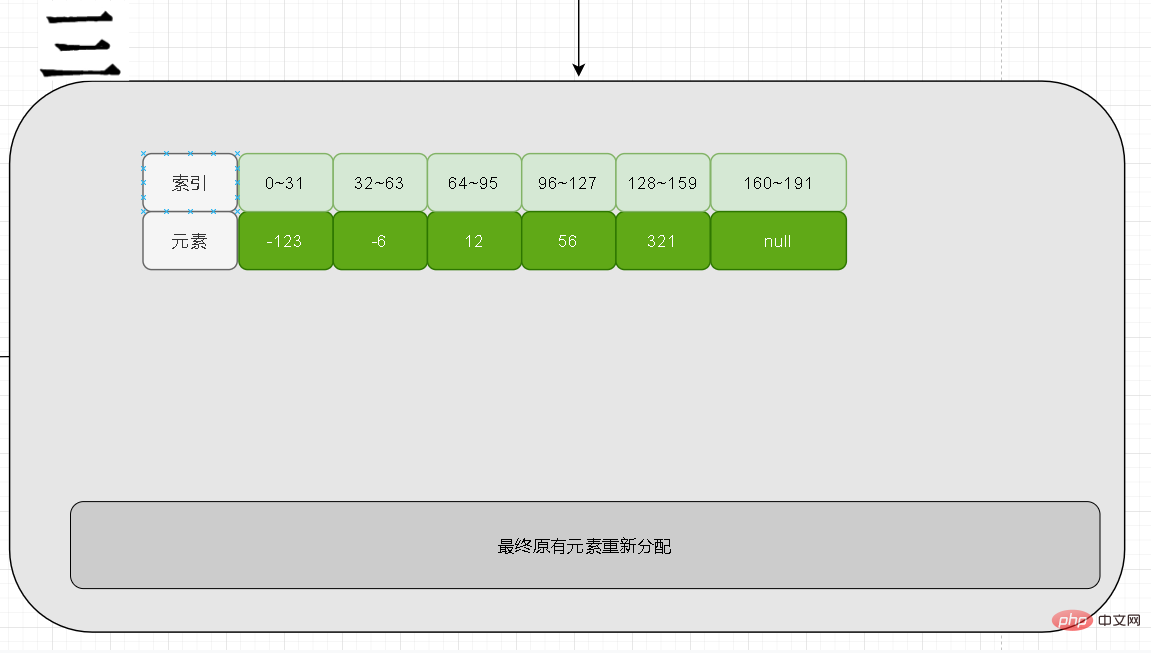
Finally fill in the newly added elements. When an upgrade occurs, it must be because the length of the new element is greater than the original length. Then his value must be at both ends of the new array. Negative numbers are on the far left, positive numbers are on the far right
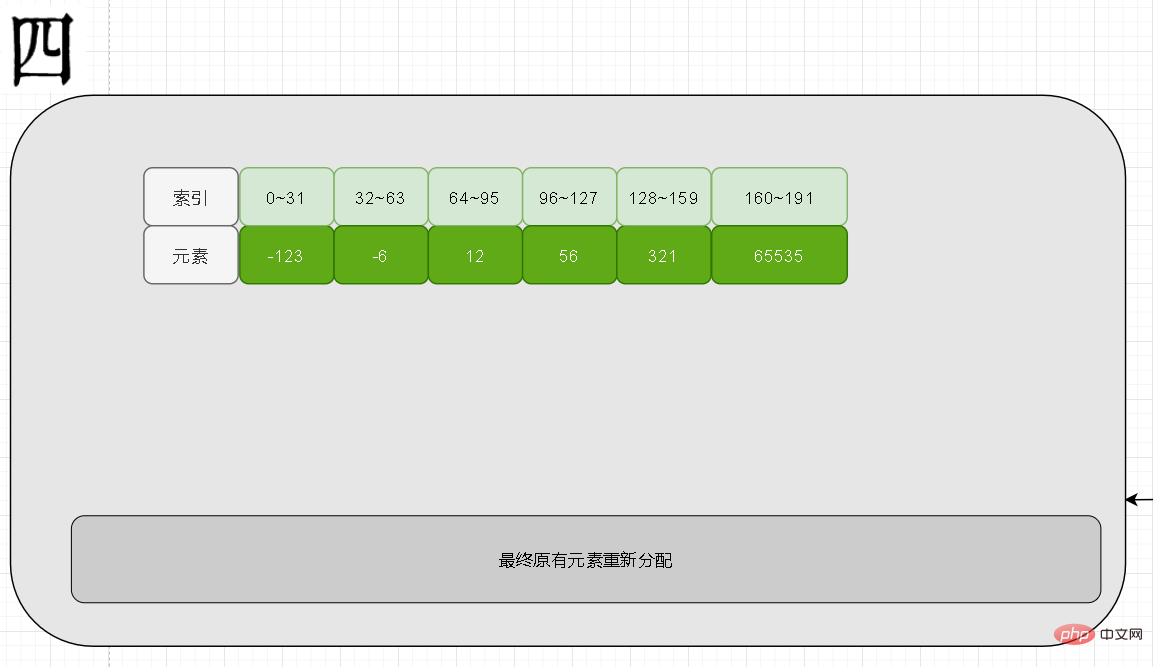
Downgrade
Then the second problem comes when the newly added 65535 is deleted. What should redis do? At this time, the actual element length is 16 bits, but the encoding is 32 bits. In my opinion, it should be downgraded!
But unfortunately redis does not, so please think about why not? If you were asked to implement it, how would you implement it? How to judge whether downgrading is needed is very difficult. We need to re-traverse whether the remaining elements are less than the current length, and the implementation complexity is O(N). This is one of the reasons why downgrading is not performed
You may say that traversing it again will be in the memory quickly anyway, so have you ever thought about upgrading and downgrading back and forth if you encounter an upgrade situation after downgrading? This reduces the performance of our program. We know that upgrading is necessary, so the strategy of downgrading redis here is to ignore it
Summary
##Related tutorial recommendations:
Redis tutorial 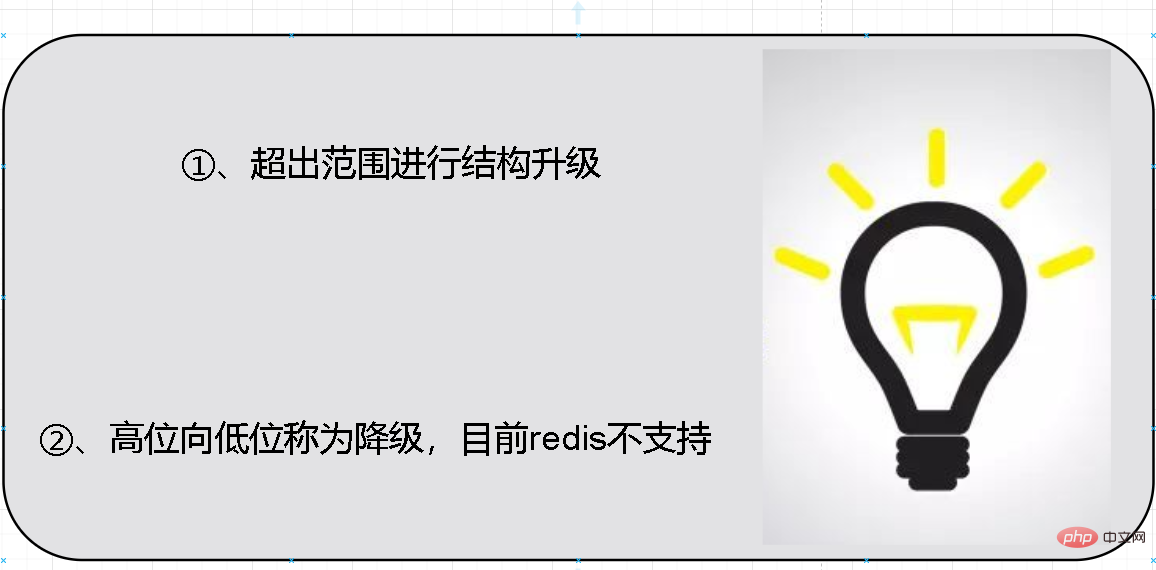
The above is the detailed content of Redis integer set cannot be downgraded? Why?. For more information, please follow other related articles on the PHP Chinese website!

Hot AI Tools

Undresser.AI Undress
AI-powered app for creating realistic nude photos

AI Clothes Remover
Online AI tool for removing clothes from photos.

Undress AI Tool
Undress images for free

Clothoff.io
AI clothes remover

Video Face Swap
Swap faces in any video effortlessly with our completely free AI face swap tool!

Hot Article

Hot Tools

Notepad++7.3.1
Easy-to-use and free code editor

SublimeText3 Chinese version
Chinese version, very easy to use

Zend Studio 13.0.1
Powerful PHP integrated development environment

Dreamweaver CS6
Visual web development tools

SublimeText3 Mac version
God-level code editing software (SublimeText3)

Hot Topics
 1669
1669
 14
14
 1428
1428
 52
52
 1329
1329
 25
25
 1273
1273
 29
29
 1256
1256
 24
24
 How to build the redis cluster mode
Apr 10, 2025 pm 10:15 PM
How to build the redis cluster mode
Apr 10, 2025 pm 10:15 PM
Redis cluster mode deploys Redis instances to multiple servers through sharding, improving scalability and availability. The construction steps are as follows: Create odd Redis instances with different ports; Create 3 sentinel instances, monitor Redis instances and failover; configure sentinel configuration files, add monitoring Redis instance information and failover settings; configure Redis instance configuration files, enable cluster mode and specify the cluster information file path; create nodes.conf file, containing information of each Redis instance; start the cluster, execute the create command to create a cluster and specify the number of replicas; log in to the cluster to execute the CLUSTER INFO command to verify the cluster status; make
 How to clear redis data
Apr 10, 2025 pm 10:06 PM
How to clear redis data
Apr 10, 2025 pm 10:06 PM
How to clear Redis data: Use the FLUSHALL command to clear all key values. Use the FLUSHDB command to clear the key value of the currently selected database. Use SELECT to switch databases, and then use FLUSHDB to clear multiple databases. Use the DEL command to delete a specific key. Use the redis-cli tool to clear the data.
 How to read redis queue
Apr 10, 2025 pm 10:12 PM
How to read redis queue
Apr 10, 2025 pm 10:12 PM
To read a queue from Redis, you need to get the queue name, read the elements using the LPOP command, and process the empty queue. The specific steps are as follows: Get the queue name: name it with the prefix of "queue:" such as "queue:my-queue". Use the LPOP command: Eject the element from the head of the queue and return its value, such as LPOP queue:my-queue. Processing empty queues: If the queue is empty, LPOP returns nil, and you can check whether the queue exists before reading the element.
 How to configure Lua script execution time in centos redis
Apr 14, 2025 pm 02:12 PM
How to configure Lua script execution time in centos redis
Apr 14, 2025 pm 02:12 PM
On CentOS systems, you can limit the execution time of Lua scripts by modifying Redis configuration files or using Redis commands to prevent malicious scripts from consuming too much resources. Method 1: Modify the Redis configuration file and locate the Redis configuration file: The Redis configuration file is usually located in /etc/redis/redis.conf. Edit configuration file: Open the configuration file using a text editor (such as vi or nano): sudovi/etc/redis/redis.conf Set the Lua script execution time limit: Add or modify the following lines in the configuration file to set the maximum execution time of the Lua script (unit: milliseconds)
 How to use the redis command line
Apr 10, 2025 pm 10:18 PM
How to use the redis command line
Apr 10, 2025 pm 10:18 PM
Use the Redis command line tool (redis-cli) to manage and operate Redis through the following steps: Connect to the server, specify the address and port. Send commands to the server using the command name and parameters. Use the HELP command to view help information for a specific command. Use the QUIT command to exit the command line tool.
 How to implement redis counter
Apr 10, 2025 pm 10:21 PM
How to implement redis counter
Apr 10, 2025 pm 10:21 PM
Redis counter is a mechanism that uses Redis key-value pair storage to implement counting operations, including the following steps: creating counter keys, increasing counts, decreasing counts, resetting counts, and obtaining counts. The advantages of Redis counters include fast speed, high concurrency, durability and simplicity and ease of use. It can be used in scenarios such as user access counting, real-time metric tracking, game scores and rankings, and order processing counting.
 How to set the redis expiration policy
Apr 10, 2025 pm 10:03 PM
How to set the redis expiration policy
Apr 10, 2025 pm 10:03 PM
There are two types of Redis data expiration strategies: periodic deletion: periodic scan to delete the expired key, which can be set through expired-time-cap-remove-count and expired-time-cap-remove-delay parameters. Lazy Deletion: Check for deletion expired keys only when keys are read or written. They can be set through lazyfree-lazy-eviction, lazyfree-lazy-expire, lazyfree-lazy-user-del parameters.
 How to optimize the performance of debian readdir
Apr 13, 2025 am 08:48 AM
How to optimize the performance of debian readdir
Apr 13, 2025 am 08:48 AM
In Debian systems, readdir system calls are used to read directory contents. If its performance is not good, try the following optimization strategy: Simplify the number of directory files: Split large directories into multiple small directories as much as possible, reducing the number of items processed per readdir call. Enable directory content caching: build a cache mechanism, update the cache regularly or when directory content changes, and reduce frequent calls to readdir. Memory caches (such as Memcached or Redis) or local caches (such as files or databases) can be considered. Adopt efficient data structure: If you implement directory traversal by yourself, select more efficient data structures (such as hash tables instead of linear search) to store and access directory information




